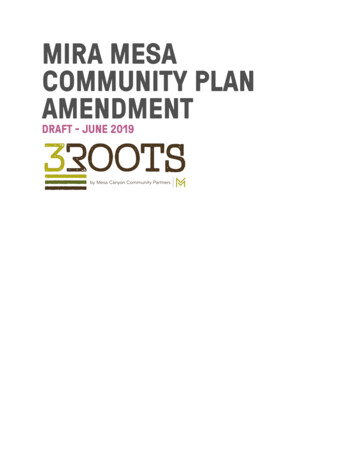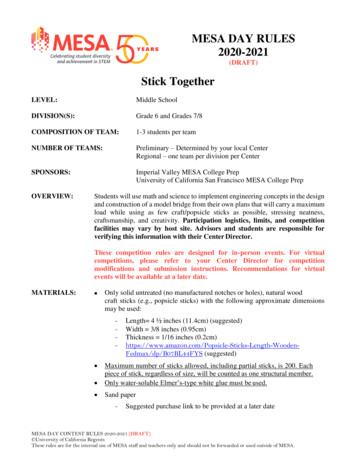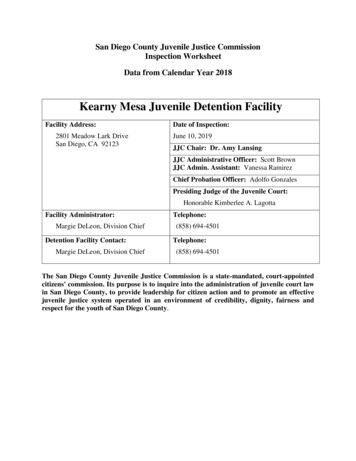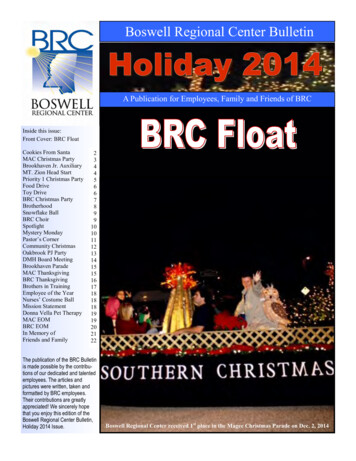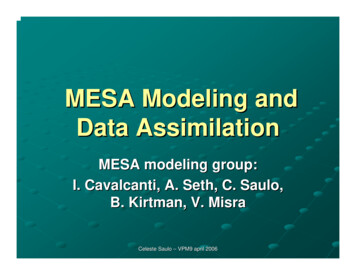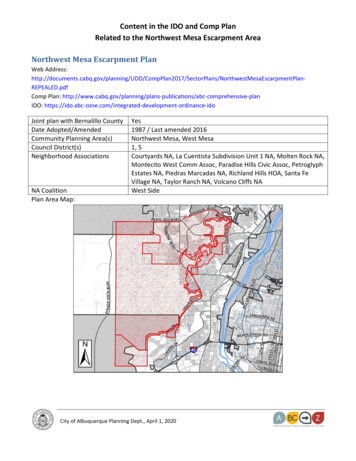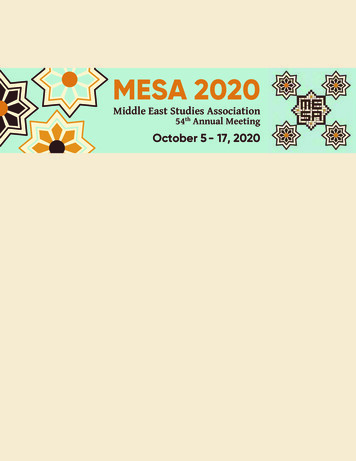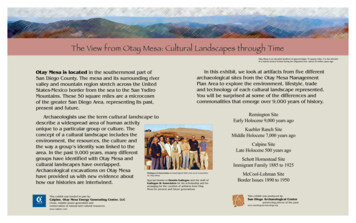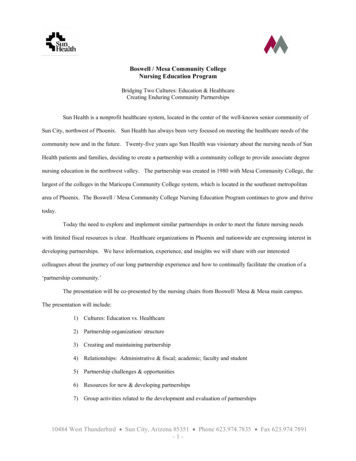
Transcription
Back to conference programBoswell / Mesa Community CollegeNursing Education ProgramBridging Two Cultures: Education & HealthcareCreating Enduring Community PartnershipsSun Health is a nonprofit healthcare system, located in the center of the well-known senior community ofSun City, northwest of Phoenix. Sun Health has always been very focused on meeting the healthcare needs of thecommunity now and in the future. Twenty-five years ago Sun Health was visionary about the nursing needs of SunHealth patients and families, deciding to create a partnership with a community college to provide associate degreenursing education in the northwest valley. The partnership was created in 1980 with Mesa Community College, thelargest of the colleges in the Maricopa Community College system, which is located in the southeast metropolitanarea of Phoenix. The Boswell / Mesa Community College Nursing Education Program continues to grow and thrivetoday.Today the need to explore and implement similar partnerships in order to meet the future nursing needswith limited fiscal resources is clear. Healthcare organizations in Phoenix and nationwide are expressing interest indeveloping partnerships. We have information, experience, and insights we will share with our interestedcolleagues about the journey of our long partnership experience and how to continually facilitate the creation of a‘partnership community.’The presentation will be co-presented by the nursing chairs from Boswell/ Mesa & Mesa main campus.The presentation will include:1) Cultures: Education vs. Healthcare2) Partnership organization/ structure3) Creating and maintaining partnership4) Relationships: Administrative & fiscal; academic; faculty and student5) Partnership challenges & opportunities6) Resources for new & developing partnerships7) Group activities related to the development and evaluation of partnerships10484 West Thunderbird Sun City, Arizona 85351 Phone 623.974.7835 Fax 623.974.7891-1-
1) Cultures: Education & HealthcareWe utilize the metaphor of a bridge for the connection or partnership between the two cultures: healthcareand education. The metaphor reflects the bridge, which joins two different cultures. We define culture as anidentified group way of thinking, feeling, believing, and behaving, which is unique to the group and typicallylearned non-verbally. We believe education and healthcare cultures are very different, in general, and, specifically,with Sun Health and Mesa CC.The bridge metaphor is also based on the idea the support for the partnership bridge must be stable andsecure in both cultures in order for the partnership to be able to function productively. The type of bridge can varyfrom a stable fixed bridge compared to a swinging bridge, which is very challenging and difficult to cross from oneside to the other. The partnership community culture is represented by the bridge. We believe the bridge metaphorcan be useful as we identify and explore the challenges of our partnership.2) Partnership organization/ structureThe healthcare organization in our partnership is Sun Health, a non-profit healthcareorganization, with two hospitals, a hospice, an Alzheimer’s Unit, a Research Center, in a seniors’ communitynorthwest of Phoenix. There are approximately 4,000 employees and 4,000 volunteers in Sun Health. Sun Healthassumes responsibility for the community and the community assumes ownership of Sun Health. The Sun Healthcommunity donates significant monies to the nursing program and student scholarshipsThe education organization in our partnership is Mesa Community College (MCC), which is the one of thelargest of the Maricopa Community Colleges, with a student enrollment of 27,834 students; 324 full-time faculty,and 960 adjunct faculty. MCC has two comprehensive campus locations plus six extended campus sites. MCC isfocused on meeting the needs of the East Valley community of over 800,000 residents.Sun Health & Mesa CC celebrated our 25th partnership this year. Our partnership is a testament to theforward thinking of both organizations twenty-five years ago. Today nursing program partnerships with educationand healthcare organizations are ‘hot’ due to the extreme nursing shortage nationwide and especially in Arizonawith one of the lowest ratios of nurses per capita.Prior to 1999, five of the ten colleges of the Maricopa Community Colleges had separate and distinctnursing program curriculums. In 1999, our partnership was the only partnership in the Maricopa nursing programs.Today the Maricopa Community Colleges has one nursing program offered at seven of our 10 colleges and hasmany other partnerships with colleges and healthcare agencies. The complexity of the inter-relatedness of the Sun10484 West Thunderbird Sun City, Arizona 85351 Phone 623.974.7835 Fax 623.974.7891-2-
Health, MCC, and Maricopa Community College District organization charts suggests many of the challenges of ourpartnership.Creating and maintaining partnershipsAlthough the Mesa/Sun Health Partnership has endured for over 25 years, we have learned a great deal andhave much to share about this process and yet, we too are still learning and still working on improving ourpartnership. Indeed, the primary reason for presenting at the Chair Conference is to assist others so that they canlearn from our success and to tell them what we wish we had known those 25 years ago. We have learned much, notonly by trial and error, but also from reading and research. Recently we discovered the non-profit organizationdesigned to foster partnerships between communities and educational institutions, Community-Campus Partnershipsfor Health (CCPH). CCPH is based at the University of California San Francisco, Center for Health Professions.One particularly helpful resource is the Bell-Elkins (2002) survey for Assessing the CCPH Principles of Partnershipin a Community –Campus Partnership. Although we recently discovered this resource, the impact has already beensubstantial.Bell-Elkins suggests that partnerships use the survey tool annually to evaluate their partnership and, fromthose results, develop an improvement plan. The principles evaluated by the survey can be a tool to strengthen anestablished partnership or used as a foundation to begin a new partnership. We trust that your partnership willbenefit from the concepts presented in her survey as well.First, the partnership needs to come together to formalize the mutual goals and mission; strategies need tobe established to develop an official contract between the partner. This process needs to include the major playersand stakeholders bringing together those who will work together once the contract is established.A written mission and vision statement for the partnership with clearly delineated goals would be a goodplace to begin the process. Both sides need to be sure that the effort to maintain the union is a win-win for bothorganizations and worth the time and energy required to sustain the partnership. The vision, mission and goals needto be developed and agreed upon by all members. A systematic plan of evaluation with measurable outcomes thatflow from the goals needs to be developed.One strategy that may be helpful would be the formation of an advisory committee for the partnership.Members need to refer to each other respectfully and use parallel titles or names. Communication between membersneeds to be free of organizational jargon and abbreviations. A process for selection of the leadership needs to bedeveloped by the stakeholders and both partners need to support the process. A process for decision making andbringing up challenges and problems between the partners needs to be established.10484 West Thunderbird Sun City, Arizona 85351 Phone 623.974.7835 Fax 623.974.7891-3-
Partnership advisory meetings need to reflect an open exchange of ideas and the meeting should remainfocused on improving the partnership. The membership should include all stakeholders and all should feel free toparticipate actively in the group discussions. Verbal and nonverbal language needs to remain congruent.An evaluation of the partnership needs be completed annually by all members and the written outcomesavailable and easily assessable to all members. Challenges and areas of concern can be identified and an action plandeveloped each year.Although the Mesa/Boswell partnership has preserved for over 25 years and the idea for a partnershipadvisory meeting seems self evident; an advisory committee was never established. In hindsight, we can clearly seethat so many difficulties would have been much more easily resolved had we had a partnership advisory group. Weare now in the process of establishing a committee and hope that you have learned from our experience and willdevelop your advisory board first.3) Relationships: Administrative, fiscal, academic, faculty and studentsOne tenet of a health partnership is a balance of power between partners and sharing of resources. Powerplays will undermine partnerships. Partners need to strive continuously for a shared balance in resources and power.It is needless to state that balance is easier to achieve in theory than in practice. This section will explore thebalance between the MCC and Boswell/Sun Health partners in fiscal, academic, faculty and student relationships.The administrative relationships between MCC and Boswell have been supportive and strong. Sun Healthassumes responsibility for all operational costs while MCC receives all tuition payments for the Boswell classes. Inaddition, Sun Health has provided over 850,000 in scholarships to the Boswell students since 2001. In 2004, SunHealth remodeled a building to house the growing nursing department. Our contract is currently in the process ofrevision to articulate more clearly the fiscal and academic responsibilities. For our MCC/Boswell partnership, bothadministrative units maximally support and strive to maintain and improve the partnership.Academic support services structure are provided by Mesa Community College (MCC) while Boswell staffprovide admission, advisement, counseling, registration, and graduation services directly to Boswell students.Financial aid is the only support services, which occasionally require the student to travel the 45 miles to MCC. Allnon-nursing courses can be taken at any Maricopa Community College while all nursing courses are taken atBoswell/Sun Health. The students graduate with an Associate in Applied Science from MCC.Without a doubt, the strongest relationship between the partners is the collegiality among all MCC andBoswell faculty. All nursing faculty, including Boswell, uses the same hiring process and faculty must meet thestandard hiring qualifications. While paychecks for Boswell faculty are distributed from MCC, Sun Health is10484 West Thunderbird Sun City, Arizona 85351 Phone 623.974.7835 Fax 623.974.7891-4-
invoiced for those salaries and benefits, which in essence means the Boswell faculty are Sun Health employees andMesa Community College employees. Boswell faculty are full members of the nursing faculty at MCCDNP withvoting rights equivalent to other nursing faculty.The working relationship between MCC nursing faculty and MCC/Boswell nursing faculty is strong. Wemeet together regularly throughout the semester. We vary the meeting place so that all faculty need to attendmeetings at several sites MCC, Boswell, and at Maricopa Community College sites midway between the partners.Sharing of a pediatric faculty member is planned to begin this fall. Of course, curriculum is identical at both sitesand all faculty are actively involved in continuously evaluating and improving the nursing curriculum and program.Student relationships between the partners are more difficult to develop. We have tried to have a districtwide Student Nurse Association but it has not yet been an active group. We have tried Student/Faculty forums, butattendance from the group that has to travel is low. Students do occasionally meet in clinical sites, but that also israre since there is such a distance between sites.4) Partnership challenges & opportunitiesThe resource, What Makes Partnerships Successful (2000), is an excellent PowerPoint presentation on theCCPH website. It describes three areas which often challenge the ability of the partnership to be effective: 1)partners and their relationships, 2) partnerships as a whole and 3) the environment in which partnerships function.One of the major challenges we have with the partners and our relationship is the need for new models ofleadership. Traditional leaders who are more comfortable with control of area of own responsibility and have nothad experience with sharing power have more difficulty than partnership leaders who are comfortable with workingin teams and sharing power and resources. The perceptual views of more traditional leaders tend to view thepartnership from only their side of the bridge, while partnership leaders tend to perceive the view from the center ofthe bridge. Our plan for the advisory meeting with partnership leadership stakeholders will provide a forum for allinvolved to hear shared concerns and work together on shared solutions.Our partnership as a whole has struggled with how to increase flexibility in the administration andmanagement of the partnership due to the fact many situations in the partnership do not fit precisely in theadministration of the college or the healthcare system. We have made significant advances in this area, however,with administrators who are able to approve a variation from the normal standard operating procedure.The issue of governance has been a major challenge for us in the partnership as a whole and theenvironment of our partnership. Our organizational chart is an attempt to delineate the complicated relationships10484 West Thunderbird Sun City, Arizona 85351 Phone 623.974.7835 Fax 623.974.7891-5-
between our partnership and the total environment. At times, the environment our partnership functions has notvalued the contribution of the partnership to the college culture but we are also making progress here.The opportunities with our partnership, however, significantly outweigh the challenges. They provideincreased number of nursing graduates, in general, to the community and, specifically, to the healthcare organizationin the partnership; improved patient care in the partner hospitals; increased revenue to the educational institution;and improved collaboration between education and practice.4) Resources for new and developing partnershipsThe Community-Campus Partnership for Health [CCPH] is a major resource for all partnerships. Inaddition to the multiple downloadable resources on partnerships, CCPH provides consultation for members, anannual conference, evaluation tools on the site, a listserv, CCPH’s monthly e-news, and more. The CCPH hasidentified ten principles of effective partnerships in a community-campus partnership, which are utilized in the BellElkins Evaluation Tool on the CCHP website. The contact information for the CCHP is below:Community-Campus Partnerships for Health CCPH Email: ccph@itsa.ucsf.edu3333 California Street, Suite 410Web: http://futurehealth.ucsf.edu/ccph.htmlSan Francisco, CA 94118Tel 415.476.7081 Fax 415.476.41135) Group activities related to the development and evaluation of partnershipsThe group activities will include selected activities interspersed throughout the presentation. They willfacilitate the participants understanding of partnership development and evaluation, utilizing the Bell-Elkins Tool.References Bell-Elkins, Julie (2002). Assessing the CCPH Principles of Partnership in Community Campus-CampusPartnership Doctoral Dissertation, CCHPCronenwett, Linda R. & Redman, Richard. (2003) Partners in Action: Nursing Education and Nursing Practice.Nurse Educator (28) 4, pp 153-155.Principles of Partnerships (1998) CCPHWhat Makes Partnerships Successful? (2000) CCPHMyrna Eshelman, Chair, Nursing, Mesa CC, has been a nurse for 36 years. Graduated from Arizona StateUniversity with a bachelors degree in nursing, Arizona State University master of science degree in maternal childnursing and certificate of women’s studies. Teaching experience includes: Nursing faculty at Phoenix College andMesa Community College. Non-faculty experience includes psychiatric nursing; maternal child nursing; andchildbirth educator.Paulette Compton, Chair, Boswell / Mesa Nursing Education Program, has been a nurse for 37 years.Graduated from the University of Maryland with BSN, Catholic University with MSN in medical-surgical nursingand teaching minor and Arizona State University with MC in counseling psychology. Nursing faculty at Univ. ofMaryland, Univ. of District of Columbia, Arizona State Univ., and Univ. of Phoenix. Non-faculty experiencesinclude shock-trauma nurse; psychiatric nurse; mental health clinical specialist; psychotherapist; organizationalmanagement consultant; and hospice creator and administrator.10484 West Thunderbird Sun City, Arizona 85351 Phone 623.974.7835 Fax 623.974.7891-6Back to conference program
Health patients and families, deciding to create a partnership with a community college to provide associate degree nursing education in the northwest valley. The partnership was created in 1980 with Mesa Community College, the largest of the colleges in the Maricopa Community College system, which is located in the southeast metropolitan area .
